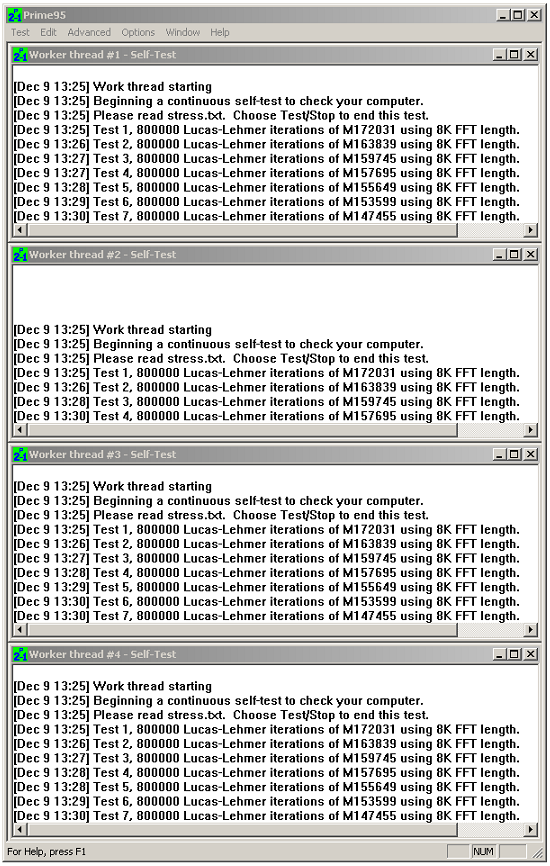Overclocking Intel's New 45nm QX9650: The Rules Have Changed
by Kris Boughton on December 19, 2007 2:00 AM EST- Posted in
- CPUs
An Unexpected Loss of Performance at Higher Speeds

It looks as though Core 1 is having trouble keeping up with the other three
We first suspected our motherboard's VRM circuitry might have been overheating while supplying the high load current. If this were the case the PWM IC would communicate with the processor using the PROCHOT pad and the CPU would respond by modulating an internal clocking signal to each core thereby artificially lowering the load and allowing the VRM to cool - a failsafe meant to save the VRM should things start to get too hot. Eventually our frustration in the matter led us to modify our board by disconnecting the control signal altogether. Unfortunately, there was no change.
We discussed the possibility of having discovered an undocumented erratum, thinking that maybe some internal control logic was at fault. The Analog Devices ADP3228 PWM controller used on the ASUS P5E3 motherboard, designed in compliance with Intel's new VRM 11.1 specification, includes a new power management feature intended to improve power circuit efficiency during periods of light loading. When directed by the CPU the VRM essentially disables four of the eight power delivery phases until they are later command back on. (This is not unlike the concept put to use in the automobile industry wherein half an internal combustion engine shuts down while cruising in order to improve fuel economy.) However, we are unable to completely rule out a possible incompatibility as no one is aware of how to go about disabling this feature.
In fact, we believe what we are seeing may be nothing more than a CPU protection mechanism in action. The Core 2 family of processors is extremely resilient to abuse - reports of failures due to overvoltage or over current incidents are exceedingly rare. Features such as these work by clamping processor input voltage (and current) to tolerable levels in order to prevent permanent damage. Further testing reveals we have some level of control with regards to the "throttling" - it seems that by slightly lowering the VID, and thus in turn the CPU supply voltage, we are able to complete testing at some of the same frequencies with no noticeable performance degradation issues. Could it be possible that we found a processor protection limit with nothing more than common water-cooling? Normally, such discoveries are the domain of those that freeze their CPUs with one or more rotary compressors or copious amounts of liquid nitrogen. Given the enormous power increases observed at these higher speeds due to what might be a processor capacitance effect, we cannot help but wonder if these new limitations are an unintended consequence of Intel's 45nm process.
If what we believe is true the implications could be enormous. The need for certain industries built on delivering high-performance cooling solutions to the overclocking community would be largely invalidated. What's the point in spending more money on a more effective heatsink if there's nothing to gain? With that said, we honestly believe a new direction in CPU overclocking may soon be upon us. While there will always be those that continue to push processors to their absolute limits, the majority of us will find our new "performance" benchmark in efficiency. This makes sense though - the market has been heading this way for years now and overclockers may have simply chosen to ignore the obvious. The multi-core era we now live in places a heavy emphasis on performance-per-watt figures and other measurable efficiencies. Does anyone else find it odd that Intel's flagship product, the QX9650, comes at exactly the same speed bin as the previous 65nm offering? All this talk of improved performance and efficiency and not even a measly frequency bump - perhaps Intel is trying to tell us something.










56 Comments
View All Comments
mczak - Wednesday, December 19, 2007 - link
Granted, that's undervolted, at stock voltage it would be more like 70W instead of 54W :-).I think the criticism of intel's TDP was justified in P4 days, which really did exceed their TDP under high load. Nowadays, the TDP (at least the numbers from intel) is pretty meaningless to the end-user, since cpus with very different actual power consumption have the same rating (QX6850 and QX9650 for example...), but at least all of their cpus actually stay below the TDP.
noobzter - Wednesday, December 19, 2007 - link
I've been waiting for articles like this that delve further into OC's intricacies. Thank you for taking the time to write such an impressive piece!ahackett - Wednesday, December 19, 2007 - link
For someone like me who's fairly new to OC-ing and has been struggling to find a technical and pragmatic introductory guide to the skill, this article is like gold-dust! I look forward to the New Year when I hope to finally remove my E6300 from its temporary ASRock housing and get some decent overclocking done :)Thanks!
BradCube - Wednesday, December 19, 2007 - link
Agreed - Fantastic article. Thanks Kris :)SoBizarre - Wednesday, December 19, 2007 - link
Yeah, the rest of Anand's staff should start thinking about securing their future. Spreading some false rumors about him visiting "Tom's Hardware" office would be a good start. Add to this a couple of sexual harassment accusations and you have a winning combination that would quickly finish his career.Guys, let me spell it for you. If you don’t take action soon, you all will be F-I-R-E-D.
Vortac - Wednesday, November 20, 2013 - link
I still come back to read this article, from time to time. One of the best, really.